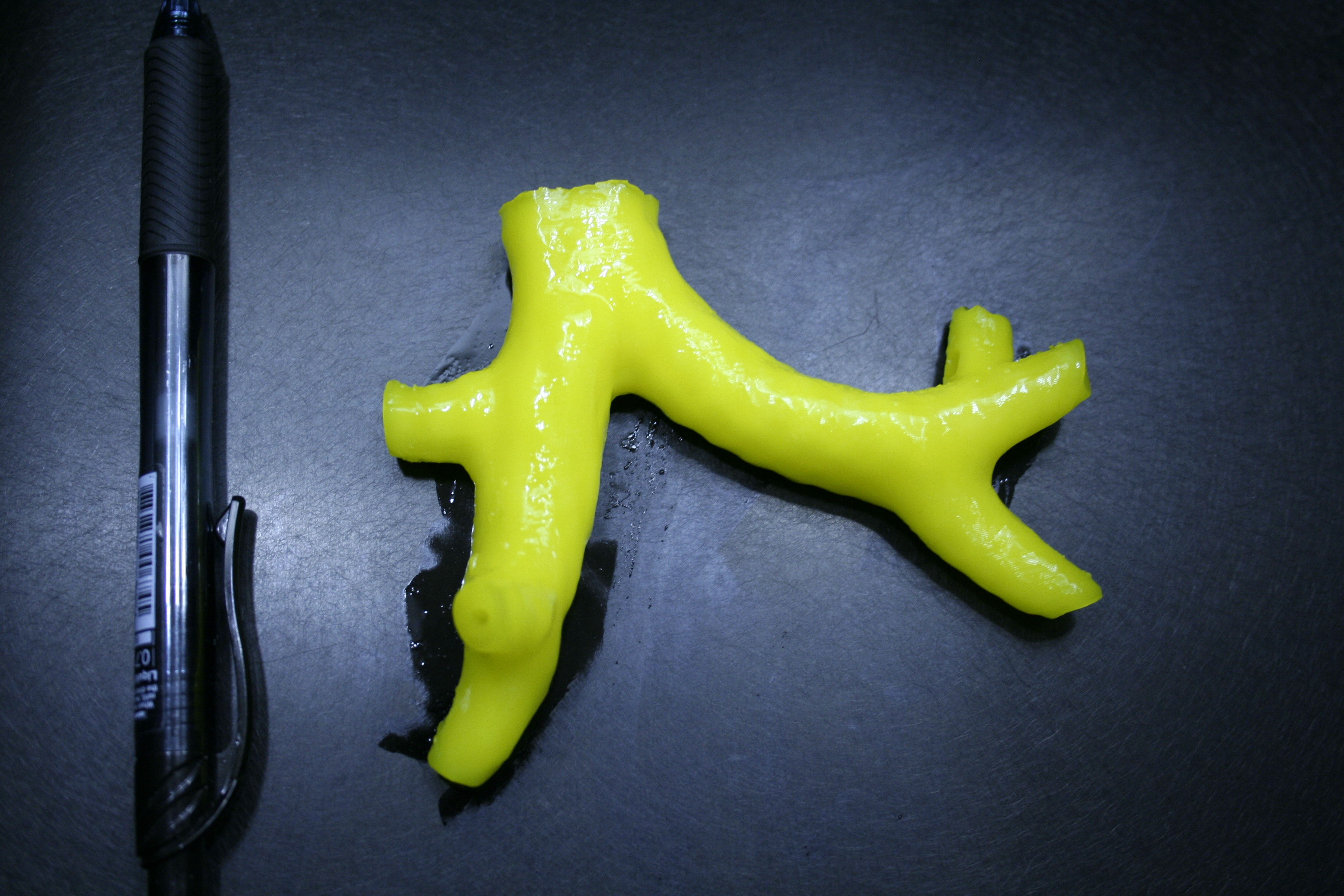Inside the effort to print lungs and breathe life into them with stem cells

Last month I had the chance to hold a replica of the upper part of a human airway—the windpipe plus the first two bronchi. It had been made from collagen, the biological cement that holds our bodies together. It was slippery and hollow, with the consistency of undercooked pasta.
The structure had emerged from a refrigerator-size 3-D printer in Manchester, New Hampshire, at an outpost of United Therapeutics, a company that earns more than a billion dollars a year selling drugs to treat lung ailments.
One day, the company says, it plans to use a printer like this one to manufacture human lungs in “unlimited quantities” and overcome the severe shortage of donor organs.
Bioprinting tissue isn’t a new idea. 3-D printers can make human skin, even retinas. Yet the method, so far, has been limited to tissues that are very small or very thin and lack blood vessels.
United instead is developing a printer that it believes will be able, within a few years, to manufacture a solid, rubbery outline of a lung in exquisite detail, including all 23 descending branches of the airway, the gas-exchanging alveoli, and a delicate network of capillaries.
A lung made from collagen won’t help anyone: it’s to a real lung what a rubber chicken is to an actual hen. So United is also developing ways to impregnate the matrix with human cells so they’ll attach and burrow into it, bringing it alive.
“We are trying to build the little stick houses for cells to live in,” says Derek Morris, a project leader in United’s organ manufacturing group.
Organ entrepreneur
The 3-D-printing project is the latest in a series of high-wire engineering efforts launched by United’s CEO, Martine Rothblatt, a onetime aerospace entrepreneur (she was the founding CEO of Sirius Satellite Radio) who changed careers in the 1990s after her daughter developed a rare lung disease.
In creating United, Rothblatt parlayed an abandoned drug she picked up for $25,000 into a company that made her the highest-paid CEO in the biopharmaceutical industry last year—when she also set a speed record in an electric helicopter. Rothblatt says she expects electric drones to someday whisk organs from her factory to wherever they are needed.
United has already made some risky organ bets. One of its subsidiaries, Revivicor, supplies surgeons with hearts, kidneys, and lungs from genetically engineered pigs (these have been used in baboons, so far). Another, Lung Bioengineering, refurbishes lungs from human donors by pumping warm solution into them. About 250 people have already received lungs that would otherwise have been designated medical waste.
Don’t expect fully manufactured organs soon. United, in its company projections, predicts it won’t happen for another 12 years. Rothblatt acknowledges that the printed structure I saw is just a start. “It’s only two branches and no cells,” she says.
Even so, United’s effort to print entire organs, which got under way last year, may be the industry’s largest. It hired a South Carolina company, 3D Systems, to build the printer and is paying another company, 3Scan, to slice up lungs and create detailed maps of their interior. It has job ads out for roles such as “Mathematician—Human Organ Design.”
United’s organ manufacturing group is located in the same complex of former textile mills as BioFabUSA, an $80 million Defense Department tissue-printing initiative. Dean Kamen, the well-known inventor who leads BioFabUSA, says meetings with Rothblatt were what led him to apply to the government to host the institute. “I saw miracles she’s playing with and the frustration of the equipment she is using to do it,” he says. To Kamen, biologists are hindered by what he calls “19th-century technology” of flasks and beakers.
3-D printing
The collagen printer 3D Systems is using now operates according to a method called stereolithography. A UV laser flickers through a shallow pool of collagen doped with photosensitive molecules. Wherever the laser lingers, the collagen cures and becomes solid. Gradually, the object being printed is lowered and new layers are added.

The printer can currently lay down collagen at a resolution of around 20 micrometers, according to United. Printing the anatomical details of a lung, however, will require features less than a micrometer in size.
“When you see the complexity of the lung, what nature does from conception to birth, there is no way to machine that or mold it. 3-D printing is the only way we have to create that geometry,” says Pedro Mendoza, director of bioprinting at 3DSystems.
Mendoza says 3D Systems plans to import techniques from the semiconductor industry—such as masks, mirrors, and more powerful lasers—to improve the printer’s resolution. Speed is also an issue. The structure I saw took 12 hours to print. A complete, detailed lung scaffold would take a year to build with the same printer.
Bioprinting
Some bioprinted tissues are close to finding medical uses. A team in Spain has been printing skin it thinks could be used on burn patients. Yet all the tissues made today are paper thin. They have to be, because they lack blood vessels. Any bigger and a tissue would die from the inside out.
While some researchers have printed prototypes of living blood vessels, these efforts remain incipient. So far, no one has claimed a $300,000 prize offered by NASA to the first scientist able to print living tissue one centimeter thick. A pair of human lungs is much more substantial, weighing about three pounds.
Some companies say it’s still premature to talk about printing entire organs. “We all think it’s going to be possible at some point in the future. Where we differ is how long it will take,” says Sharon Presnell, chief scientist of Organovo, a California company that has been printing thin, elastic sheets of liver. “Can you get something that size with a vasculature, and can it take physiological pressure? Most of us are trying to walk before we run.”
Adding cells
Not United, though. It says the problem with other efforts is that they use extrusion methods, squeezing cells and proteins through fine needles. Luis Alvarez, the bioengineer who heads United's organ manufacturing group, likens printing cells to “pushing water balloons through a straw.” He says, “Your printing resolution is limited by the size of the cell.”
Instead, United’s plan is to print a lung scaffold first and then infuse it with human cells, a process called recellularization.
There is early evidence that a collagen matrix can be turned back into a functioning lung. This year, in an experiment partly financed by United, Harvard University experimental surgeon Harald Ott reported that he’d pumped billions of human cells (from umbilical cords and diced lungs) into a pig lung stripped of its own cells. When Ott’s team reconnected it to a pig’s circulation, the resulting organ showed rudimentary function, although the experiment lasted only an hour.
“You do get blood through the system, and you do get gas exchange,” says Finn Hawkins, a stem-cell biologist at Boston University, who is not involved in United’s project. “That is remarkable. But it’s a long way to transplantable organs.”
Hawkins says that Ott’s organs lacked important cell types, like the wavy cilia that remove phlegm. What’s more, it remains unclear how to obtain human cells in the quantities needed to supply a future organ factory. There aren’t enough human lungs from deceased donors to meet the demand.
United says it plans to use stem cells to manufacture the needed tissue in its labs, but that's no easy task either.
“I think the bioprinting may be the least problematic part of it,” Hawkins says. “As soon as you mention anything larger than a mouse, I would say it’s hard to make that quantity of cells.”
New organs
If organs could be manufactured in large numbers, it wouldn’t only solve the organ shortage. It could eventually reshape human life span. What about getting a new heart or lungs at 80?
To get there, United will have to pull off not one but several technological moonshots. Yet Alvarez says United is anticipating that its various technology projects—the 3-D-printed scaffold, the recellularization technique, and its effort to manufacture lung tissue from stem cells—will all intersect sometime in the future.
“By the time we get to printing the finest part of the lung,” he says, “we’ll know how to recellularize it.”
Deep Dive
Biotechnology and health
How scientists traced a mysterious covid case back to six toilets
When wastewater surveillance turns into a hunt for a single infected individual, the ethics get tricky.
An AI-driven “factory of drugs” claims to have hit a big milestone
Insilico is part of a wave of companies betting on AI as the "next amazing revolution" in biology
The quest to legitimize longevity medicine
Longevity clinics offer a mix of services that largely cater to the wealthy. Now there’s a push to establish their work as a credible medical field.
There is a new most expensive drug in the world. Price tag: $4.25 million
But will the latest gene therapy suffer the curse of the costliest drug?
Stay connected
Get the latest updates from
MIT Technology Review
Discover special offers, top stories, upcoming events, and more.